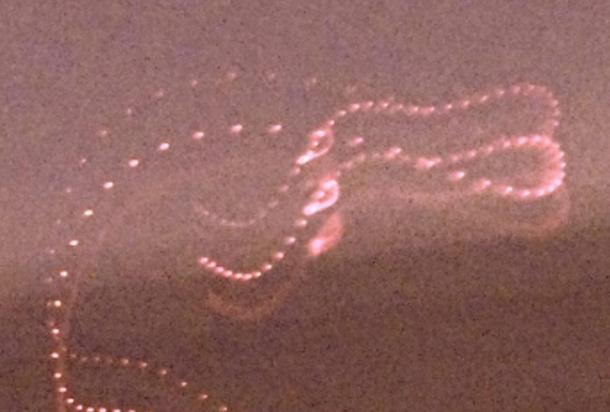The galaxy NGC 5427 shines in this new NASA Hubble Space Telescope image. It’s part of the galaxy pair Arp 271, and its companion NGC 5426 is located below this galaxy and outside of this image’s frame. However, the effects of the pair’s gravitational attraction is visible in the galactic distortion and cosmic bridge of stars seen in the lower-right region of the image. …read more […]
|
|
||
|
In contrast to conventional mirrors, light can be reflected on surfaces known as metasurfaces without changing its polarization. This phenomenon has now been proven by physicists at Friedrich-Alexander-Universität Erlangen-Nürnberg (FAU) and the Max Planck Institute for the Science of Light (MPL). The discovery enables circulating light to be used to reliably detect chiral molecules. …read more […] The α particle, also known as helium-4, consists of two protons and two neutrons. Although it is one of the most extensively studied atomic nuclei, the precise nature of its excited states remains unclear. …read more […] Solitons are quasiparticles that propagate along a non-dissipative wave. Put another way, they are waveforms that hold their shape as they move—like a single wave moving across the surface of a pond. They can also show particle-like behavior, such as collision, attraction, and repulsion. …read more […] Using XMM-Newton, Chandra and NuSTAR space telescopes, an international team of astronomers has explored the nature of a recently-detected very-high-energy source designated 2FHL J1745.1–3035. Results of the study, published Jan. 24 on the pre-print server arXiv, suggested that the source may be a pulsar wind nebula. …read more […] A love for space exploration led Jessica Atkin, a Texas A&M College of Agriculture and Life Sciences graduate student in the Department of Soil and Crop Sciences, to produce the first-ever moondust-grown chickpeas. …read more […] Physicists from the University of Rostock, the Cluster of Excellence ct.qmat, the Julius-Maximilians University of Würzburg and the Indiana University Indianapolis (IUPUI) have shown for the first time that light can propagate without any loss in systems that interact with their environment. Previously, it was assumed that such open systems inevitably would exhibit exponential amplification or damping of light and thus lead to the instability of the system. …read more […] 
YouTube Video Here: https://www.youtube.com/embed/_gRC2q_VLEM?feature=oembed&enablejsapi=1 These mysterious images are allegedly proof that ‘invisible Alien entities ARE here on Earth’. Researchers seeking evidence of anti-matter in the universe firmly believe they have come across a previously unknown ‘invisible life form’ on planet Earth. The group of researchers that discovered …read more […] Surrounded by the desert mountains and clear blue sky of northern Chile, astronomers from the Vera C. Rubin Observatory hope to revolutionize the study of the universe by affixing the world’s largest-ever digital camera to a telescope. …read more […] …read more […] 
YouTube Video Here: https://www.youtube.com/embed/EqmpT6T_2tU?feature=oembed&enablejsapi=1 You just gotta love history and archaeology and all excitement that come with them. In this article, we take a look at some of the most incredible ancient monuments and ruins left behind by people thousands of years ago. From the Pyramids to underwater monuments, we take a look at the most incredible, breathtaking and mysterious monuments ever erected by mankind in the distant past. The ancient ruins of Sayhuite and the Sayhuite Monolith This archaeological site is located in Peru and is significant because it is …read more […] This high exposure photograph revealed Earth’s atmospheric glow against the backdrop of a starry sky in this image taken from the International Space Station on Jan. 21, 2024. At the time, the orbital lab was 258 miles above the Pacific Ocean northeast of Papua New Guinea. The Nauka science module and Prichal docking module are visible at left. …read more […] Laser sources operating at the 1.2 μm wavelength band have some unique applications in photodynamic therapy, biomedical diagnosis and oxygen sensing. Additionally, they can be adopted as pump sources for mid-infrared optical parametric generation as well as visible light generation by frequency doubling. …read more […] On April 8, the moon’s shadow will sweep across the United States, as millions will view a total solar eclipse. For many, preparing for this event brings memories of the magnificent total solar eclipse on Aug. 21, 2017. …read more […] Do exoplanets have exomoons? It would be extraordinary if they didn’t, but as with all things, we don’t know until we know. Astronomers thought they may have found exomoons several years ago around two exoplanets: Kepler-1625b and Kepler-1708b. Did they? …read more […] |
||
|
Copyright © 2024 Paranormal News Network - All Rights Reserved Powered by WordPress & Atahualpa 133 queries. 0.385 seconds. |
||

